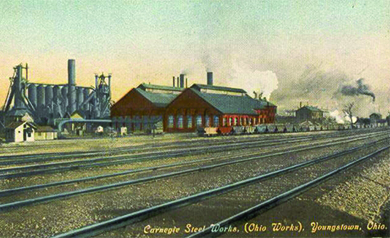| << Chapter < Page | Chapter >> Page > |
Andrew Carnegie, steel magnate, has the prototypical rags-to-riches story. Although such stories resembled more myth than reality, they served to encourage many Americans to seek similar paths to fame and fortune. In Carnegie, the story was one of few derived from fact. Born in Scotland, Carnegie immigrated with his family to Pennsylvania in 1848. Following a brief stint as a “bobbin boy,” changing spools of thread at a Pittsburgh clothing manufacturer at age thirteen, he subsequently became a telegram messenger boy. As a messenger, he spent much of his time around the Pennsylvania Railroad office and developed parallel interests in railroads, bridge building, and, eventually, the steel industry.
Ingratiating himself to his supervisor and future president of the Pennsylvania Railroad, Tom Scott, Carnegie worked his way into a position of management for the company and subsequently began to invest some of his earnings, with Scott’s guidance. One particular investment, in the booming oil fields of northwest Pennsylvania in 1864, resulted in Carnegie earning over $1 million in cash dividends, thus providing him with the capital necessary to pursue his ambition to modernize the iron and steel industries, transforming the United States in the process. Having seen firsthand during the Civil War, when he served as Superintendent of Military Railways and telegraph coordinator for the Union forces, the importance of industry, particularly steel, to the future growth of the country, Carnegie was convinced of his strategy. His first company was the J. Edgar Thompson Steel Works, and, a decade later, he bought out the newly built Homestead Steel Works from the Pittsburgh Bessemer Steel Company. By the end of the century, his enterprise was running an annual profit in excess of $40 million ( [link] ).

Although not a scientific expert in steel, Carnegie was an excellent promoter and salesman, able to locate financial backing for his enterprise. He was also shrewd in his calculations on consolidation and expansion, and was able to capitalize on smart business decisions. Always thrifty with the profits he earned, a trait owed to his upbringing, Carnegie saved his profits during prosperous times and used them to buy out other steel companies at low prices during the economic recessions of the 1870s and 1890s. He insisted on up-to-date machinery and equipment, and urged the men who worked at and managed his steel mills to constantly think of innovative ways to increase production and reduce cost.
Carnegie, more than any other businessman of the era, championed the idea that America’s leading tycoons owed a debt to society. He believed that, given the circumstances of their successes, they should serve as benefactors to the less fortunate public. For Carnegie, poverty was not an abstract concept, as his family had been a part of the struggling masses. He desired to set an example of philanthropy for all other prominent industrialists of the era to follow. Carnegie’s famous essay, The Gospel of Wealth , featured below, expounded on his beliefs. In it, he borrowed from Herbert Spencer’s theory of social Darwinism , which held that society developed much like plant or animal life through a process of evolution in which the most fit and capable enjoyed the greatest material and social success.

Notification Switch
Would you like to follow the 'U.s. history' conversation and receive update notifications?